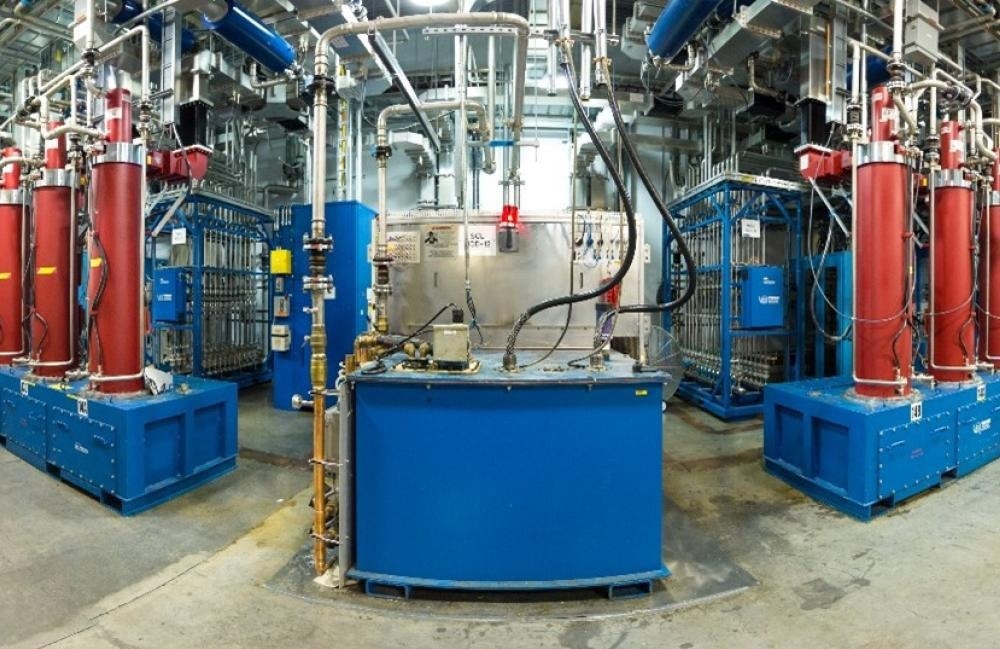The particle accelerator beam operating power of the Spallation Neutron Source at the Department of Energy’s Oak Ridge National Laboratory hit 1.7 megawatts, breaking the previous record by a wide margin.
 Upgrades to the particle accelerator enabling the record 1.7-megawatt beam power at the Spallation Neutron Source included adding 28 high-power radio-frequency klystrons (red tubes) to provide higher power for the accelerator. Image Credit: Genevieve Martin/ORNL, US Dept. of Energy
Upgrades to the particle accelerator enabling the record 1.7-megawatt beam power at the Spallation Neutron Source included adding 28 high-power radio-frequency klystrons (red tubes) to provide higher power for the accelerator. Image Credit: Genevieve Martin/ORNL, US Dept. of Energy
The enhanced power of the accelerator gives researchers who utilize the facility more neutrons to investigate and enhance a variety of materials for more effective solar panels, longer-lasting batteries, and stronger, lighter transportation components.
The accomplishment establishes a new operational benchmark for neutron scattering in the US and provides a platform for taking on increasingly challenging problems and obstacles in the field of materials science.
This increase in beam power represents another milestone in the Proton Power Upgrade project, an essential component in enabling new science at the SNS, including insights into advanced materials for clean energy applications. I commend our staff for their efforts in accomplishing this new record.
Jeff Smith, Interim Director, Oak Ridge National Laboratory
Since its construction was finished in 2006, the SNS has been a top-tier DOE Office of Science user facility, offering thousands of researchers from across the world the highly advanced scientific capabilities they need to explore energy phenomena and materials down to the atomic scale.
Using a 300-meter linear accelerator, an accumulator ring, and a target made of liquid mercury, the facility accelerates protons to create neutrons. Researchers can investigate the atomic structure and behavior of various materials by using the “spall” of neutrons sent to the area’s research equipment upon impact.
High-speed detectors catch the scattered neutrons from the material’s atoms after they have been detected by the dispersion, which provides researchers with important data to study.
A particle accelerator’s beam power is measured in megawatts. Following the most recent installation of new accelerating equipment as part of the ongoing Proton Power Upgrade project at the accelerator, the SNS’s 1.7-megawatt power level was attained.
ORNL’s Proton Power Upgrade will continue to push the particle accelerator’s beam power up to 2.8 megawatts. This will increase the number of neutrons available for experiments at the existing First Target Station to enable new discoveries and power the planned Second Target Station, a complementary third neutron source at ORNL.
STS will address emerging science challenges through experiments not currently feasible nor routine, with the ability to study smaller or less-concentrated samples or those under more extreme environmental conditions.
The High Flux Isotope Reactor, in addition to SNS, is located at ORNL. The steady-state neutron beam at HFIR, which was finished in 1965 and runs at 85 megawatts, is the most powerful reactor-based neutron source in the country.
The SNS and HFIR facilities generate neutron beams that contribute to the development of inventions that enhance daily living, such as more potent computers, cleaner environments, more potent medicines, and long-lasting batteries.